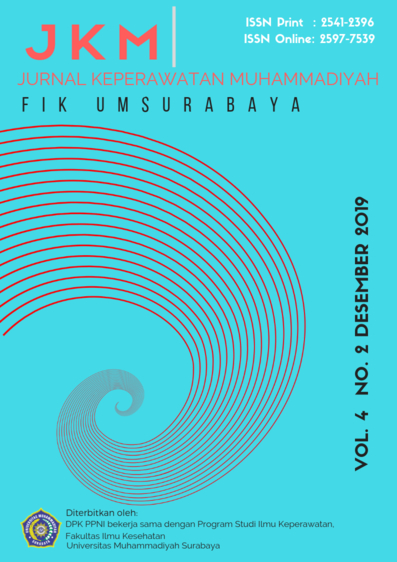Analisis Penggunaan Gadgegt dan Interaksi Sosial Anak Usia Pra Sekolah di Taman Kanak-Kanak Yogyakarta
Kata Kunci:
Gadgets, social interactions, pre-school childrenAbstrak
Objective: to identify the use of gadget and socialinteraction of preschool age at kindergaten in Yogyakarta.
Methods: Â The research was conducted at PKK Kindergarten, Maguwoharjo, Sleman Yogyakarta. The research design was Cross Sectional. The study population is the father/mother who has children using gadgets with a sample of 45 respondents using total sampling. Data collection tools are questionnaires. Analysis is done by using Somers'd test.
Results:  The most age of respondents was early adulthood, 22 respondents (48.9%). Most of the respondents' education is medium, 27 respondents (60.0%). Most of respondents were housewives, 23 respondents (51.1%). Most the children were 6 years old, 28 children (62.2%). Most of the sexes of children are female, 27 children (60.0%). The use of gadget is medium category, 20 respondents (44.4%). Most of the respondents were good category of social interactions, 32 respondents (71.1%). The results of bivariate analysis between the age of the child, parental education, and parent’s job with the use of gadgets obtained p-value 0.010; 0.024; and 0.003. The results of bivariate analysis between the age of the child, parental education, parent’s job, and the use of gadgets with social interaction obtained p-value 0.028; 0.041; 0.002, and 0.007 Conclusion:  There is a relationship between the age of the child, parental education, and parent’s job with the use of gadgets of preschool children.There is a relationship between the age of the child, parental education, parent’s job, and the use of gadgets with social interaction of preschool children.
Referensi
Fibriyani R. (2014). Model Interaksi Sosial Peran Teman Sebaya Dalam Pembentukan Nilai Kepribadian Siswa di Lingkungan Sekolah. Thesis. Universitas Lampung.
Haqq, Akbar T. (2016). Hubungan Intensitas Bermain Game Online Terhadap Agresivitas Remaja Awal Di Warnet “A, B, Dan C†Kecamatan Lowokwaru Kota Malang. Skripsi. Universitas Islam Negeri Maulana Malik Ibrahim Malang.
Hidayat, Alimul Aziz (2007). Metode Penelitian Keperawatan dan Teknik Analisa Data. Jakarta: Salemba Medika
Lailiyah, F. (2016). “Meningkatkan Kecerdasan Interpersonal Anak Melalui Corat-Coret (Doodling) Pada Anak Usia Dini Yang Cenderung Bermain Gadgetâ€. Skripsi. Universitas Islam Negeri Sunan Ampel Surabaya.
Lioni, T., Holilulloh, Nurmalisa, Y. (2013). Pengaruh Penggunaan Gadget Pada Peserta Didik Terhadap Interaksi Sosial. Jurnal Kultur Demokrasi Vol 2 (2). http://www.e-journal.com/2015/09/pengaruh-penggunaan-gadget-pada-peserta.html. Diakses pada 13 Oktober 2016.
Notoadmodjo, S. (2007). Pendidikan dan Perilaku Kesehatan. Jakarta: Rineka Cipta.
_____________. (2012). Metodologi Penelitian Kesehatan. Jakarta: Rineka Cipta.
Novitasari, W., & Khotimah, N. (2016). Dampak Penggunaan Gadget Terhadap Interaksi Sosial Anak Usia 5-6 Tahun. PAUD Teratai Vol 5 (3). http://ejournal.unesa.ac.id/article/21231/19/article.pdf. Diakses pada 06 Oktober 2016.
Ratnadewi. (2010). Peran Orang Tua pada Terapi Biomedis untuk Anak Autis. Jakarta: Fakultas Psikologis Universitas Gunadarma.
Sari, D.P. (2014). Hubungan Antara Intensitas Penggunaan Gadget Dengan Perilaku Prososial Pada Anak Usia Middle Childhood. Skripsi: Universitas Mercubuana. http://digilib.mercubuana.ac.id/manager/n!@fileskripsi/Isi3406783057668.pdf. Diakses pada 26 Jaunari 2017.
Sari, Tria P. & Mitsalia, Amy A. (2016). Pengaruh Penggunaan Gadget Terhadap Personal Sosial Anak Usia Pra Sekolah di TKIT Al Mukmin. Profesi (Profesional Islam) Media Publikasi Penelitian. Vol. 13 (2). http://ejournal.stikespku.ac.id.pdf. Diakses pada 26 Oktober 2016.
Simamora A. SM. (2016). Persepsi Orangtua Terhadap Penggunaan Gadget Pada Anak Usia Pendidikan Dasar Di Perumahan Bukit Kemiling Permai Kecamatan Kemiling Bandar Lampung. Skripsi. Universitas Lampung.
Soekanto, S. (2012). Sosiologi Suatu Pengantar. Jakarta : Rajawali Press.
Susanto Ahmad. (2012). Perkembangan Anak Usia Dini. Jakarta: Kencana Perdana Media Group.
Walgito, B. (2003). Psikologi Sosial (Suatu Pengantar). Yogyakarta: Andi Yogyakarta.
Widiawati, I., Sugiman, H., & Edy. (2014). Pengaruh Penggunaan Gadget Terhadap Daya Kembang Anak. Prosiding Seminar Nasional Multidisiplin Ilmu. Universitas Budi Luhur.
Unduhan
Diterbitkan
Terbitan
Bagian
Lisensi
- Penulis tetap memegang hak atas karyanya dan memberikan hak publikasi pertama kepada jurnal ini yang secara simultan karya tersebut dilisensikan di bawah:Â Creative Commons Attribution-ShareAlike 4.0 International (CC BY-SA 4.0)













